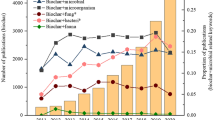Summary
Physical, chemical, and population changes among microorganisms in a eucalyptus bark mix were examined during composting. The microbial succession was studied in detail by dilution plating. The CO2 evolution corresponded to high microbial numbers. The pH increased rapidly, from 4 to 7.5, before stabilizing at approximately 6.5. Composting increased the availability of most nutrients. Initially, bacteria and filamentous fungi appeared to be the main decomposing organisms. With time, however, yeasts and actinomycetes increased in numbers. The numbers of spore-forming bacteria (Bacillus spp.) and pseudomonads also increased with time. The compost was initially phytotoxic, but ceased to be so within 76 days.
Similar content being viewed by others
References
Bagstam G (1977) Experiments made in bench scale composters: III. Composting of spruce bark together with sewage sludge. Vatten 3:239–251
Bagstam G (1978) Population changes in microorganisms during composting of sprucebark: I. Influence of temperature control. Eur J Appl Microbiol Biotechnol 5:315–330
Bagstam G (1979) Population changes in microorganisms during composting of spruce bark: II. Mesophilic and thermophilic microorganisms during controlled composting. Eur J Appl Microbiol Biotechnol 6:279–288
Baines S, Svoboda IF, Evans MR (1985) Heat from aerobic treatment of liquid animal wastes. In: Gasser JKR (ed) Composting of agricultural and other wastes. Elsevier, London New York, pp 47–160
Cappaert I, Verdonk O, De Boodt M (1975) Composting of hardwood bark. Compost Sci 16:12–15
Chang Y, Hudson HJ (1967) The fungi of wheat straw compost: I. Ecological studies. Trans Br Mycol Soc 50:649–666
Cuppels D, Kelman A (1974) Evaluation of selective media for isolation of soft-rot bacteria from soil and plant tissue. Phytopathology 64:468–475
Finstein MS, Miller FC (1985) Principles of composting leading to maximization of decomposition rate, odour control, and cost effectiveness. In: Gasser JKR (ed) Composting of agricultural and other wastes. Elsevier, London New York, pp 13–26
Golueke CG (1972) Composting: A study of the process and its principles. Rodale Press, Emmaus, Penn
Hardy GE St J, Sivasithamparam K (1988) Phytophthora spp. associated with container-grown plants in nurseries in Western Australia. Plant Dis 72:435–437
Haug RT (1980) Compost engineering principles and practice. Ann Arbor, Arbor Science, Mich
Hoitink HAJ (1980) Composted bark, a lightweight growth medium with fungicidal properties. Plant Dis 64:142–147
Hoitink HAJ, Fahy PC (1986) Basis for the control of soilborne plant pathogens with composts. Annu Rev Phytopathol 24:93–114
Hoitink HAJ, Poole HA (1980) Factors affecting quality of composts for utilization in container media. Hortscience 15:171–173
Hoitink HAJ, Wilson JH, Poole HA (1978) Factors affecting composting of hardwood tree bark. In: Proceedings Second Wood Ornamental Disease Workshop. University Missouri, Columbia, pp 11–18
Hong C-Y, Ueyama A (1973) An example of utilization of wood waste deposit: Manufacture of fortified bark compost having a decreased ability to support outbreak of soil-borne plant diseases. Stockholm Skogshogskolan Inst Virkeslara Rapp 83:1–13
Jeris JS, Regan RW (1973) Controlling environmental parameters for optimum composting: I. Experimental procedure and temperature. Compost Sci 14:10–15
King NR, Ward MK, Raney DE (1954) Two simple media for the demonstration of pyocyanin and fluorescin. J Lab Clin Med 44:301
Lynch JM, Wood DA (1985) Controlled microbial degradation of lignocellulose: the basis for existing and novel approaches to composting. In: Gasser JKR (ed) Composting of agricultural and other wastes. Elsevier, London New York, pp 183–193
Martin JP (1950) Use of acid, rose bengal and streptomycin in the plate method of estimating soil fungi. Soil Sci 69:215–232
Poincelot RP (1972) The biochemistry and methodology of composting. Bull 727, Conn Agric Exp Stn
Sivasithamparam K (1981) Some effects of extracts from tree barks and sawdust on Phytophthora cinnamomi Rands. Aust Plant Pathol 10:18–20
Sivasithamparam K, Parker CA, Edwards CS (1979) Rhizosphere micro-organisms of seminal and nodal roots of wheat grown in pots. Soil Biol Biochem 11:155–160
Sivasithamparam K, Smith LDJ, Goss OM (1981) Effect of potting media containing fresh sawdust and composted tree-barks-on Phytophthora cinnamomi Rands. Aust Plant Pathol 10:20–21
Solbraa K, Sant MD, Selmer-Olsen AR, Gislerod HR (1983) Composting soft and hardwood barks. Biocycle 24:44–48
Still SM, Dirr MA, Gartner JG (1976) Phytotoxic effects of several bark extracts on Mung bean and cucumber growth. Am J Soc Hort Sci 101:34–37
Stutzenberger FJ, Kaufmann AJ, Lossin RD (1970) Cellulolytic activity in municipal solid waste composting. Can J Microbiol 16:553–560
Suler DJ, Finstein MS (1977) Effect of temperature, aeration, and moisture and CO2 formation in bench-scale, continuously thermophilic composting of solid waste. Appl Environ Microbiol 33:345–350
Warcup JH (1960) Methods for isolation and estimation of activity of fungi in soil. In: Parkinson D, Waid JS (eds) Ecology of soil fungi. Liverpool University Press, Liverpool, pp 3–21
Zucconi F, Forte M, Monaco A, Bertoldi de M (1981a) Biological evaluation of compost maturity. Biocycle 22:27–29
Zucconi F, Pera A, Forte M, Monaco A, Bertoldi de M (1981b) Evaluating toxicity of immature compost. Biocycle 22:54–57
Author information
Authors and Affiliations
Rights and permissions
About this article
Cite this article
Hardy, G.E.S.J., Sivasithamparam, K. Microbial, chemical and physical changes during composting of a eucalyptus (Eucalyptus calophylla and Eucalyptus diversicolor) bark mix. Biol Fert Soils 8, 260–270 (1989). https://doi.org/10.1007/BF00266489
Received:
Issue Date:
DOI: https://doi.org/10.1007/BF00266489




